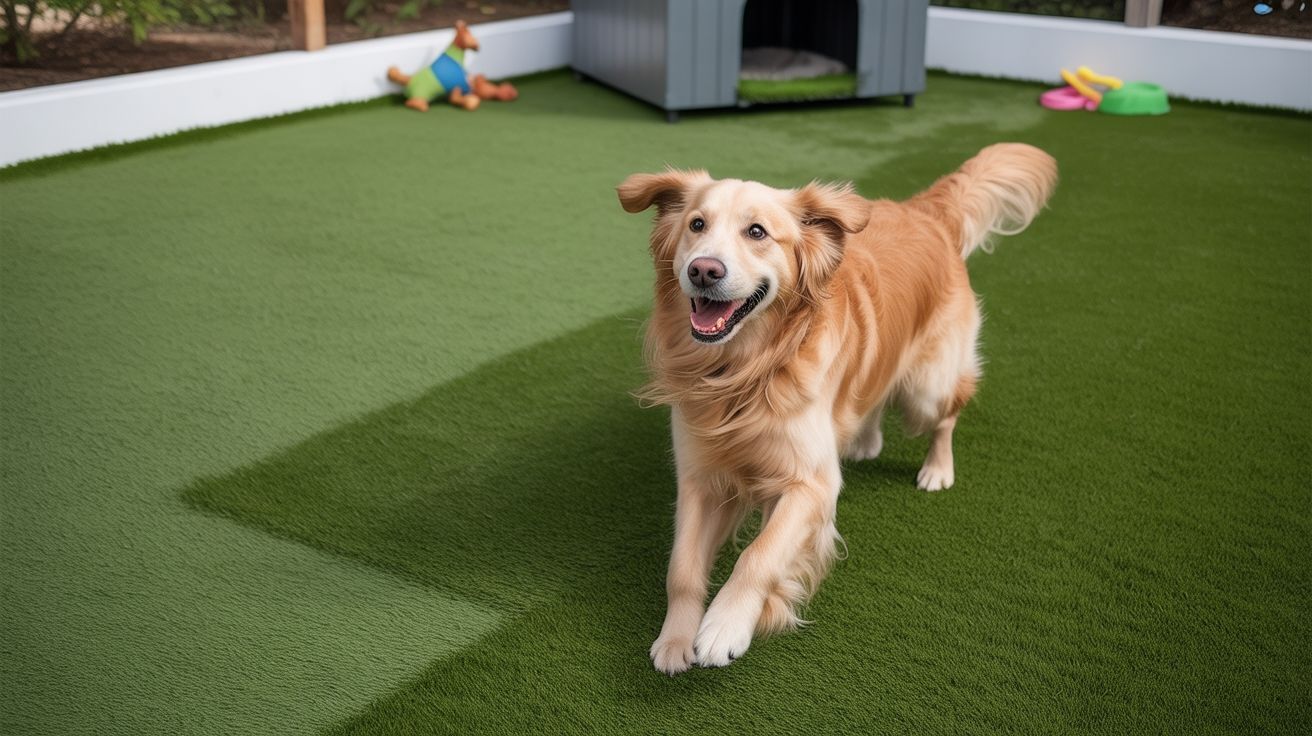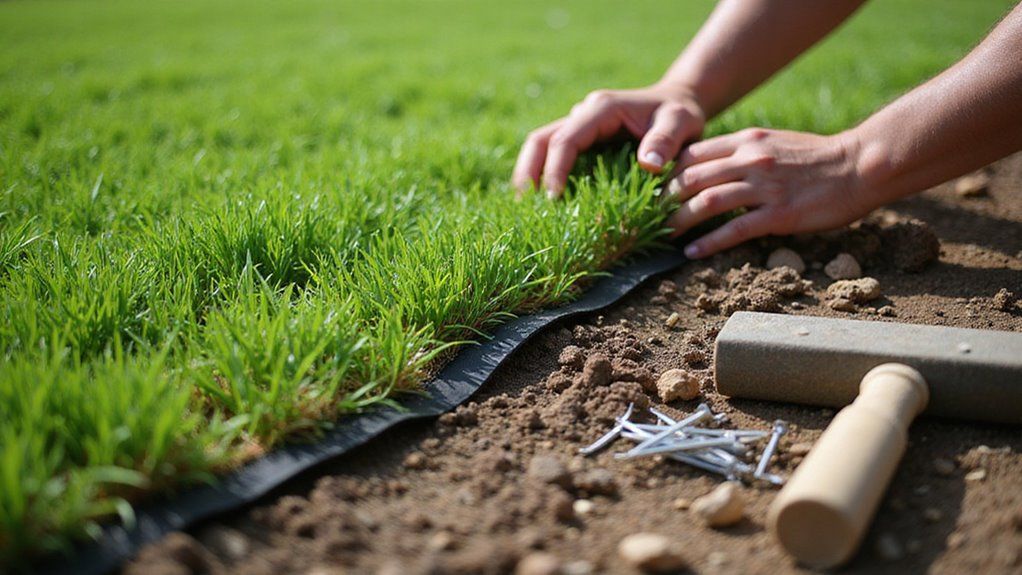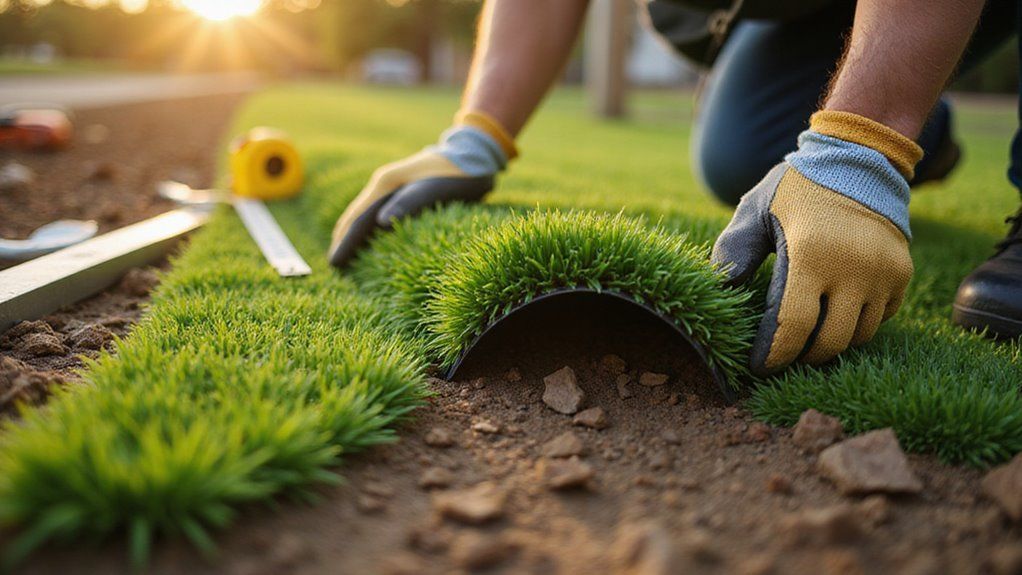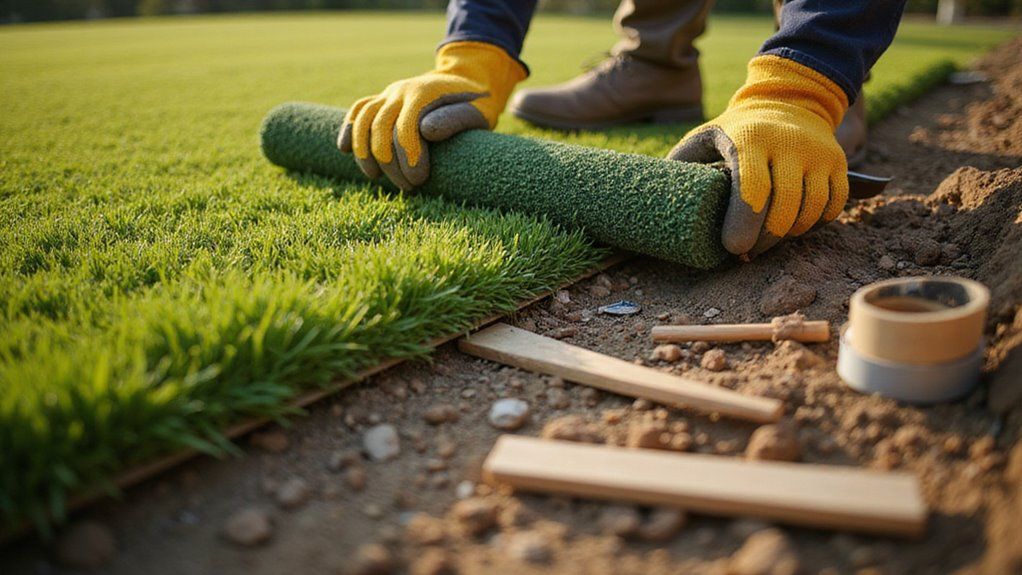Do You Put Sand Down Before Laying Artificial Turf?
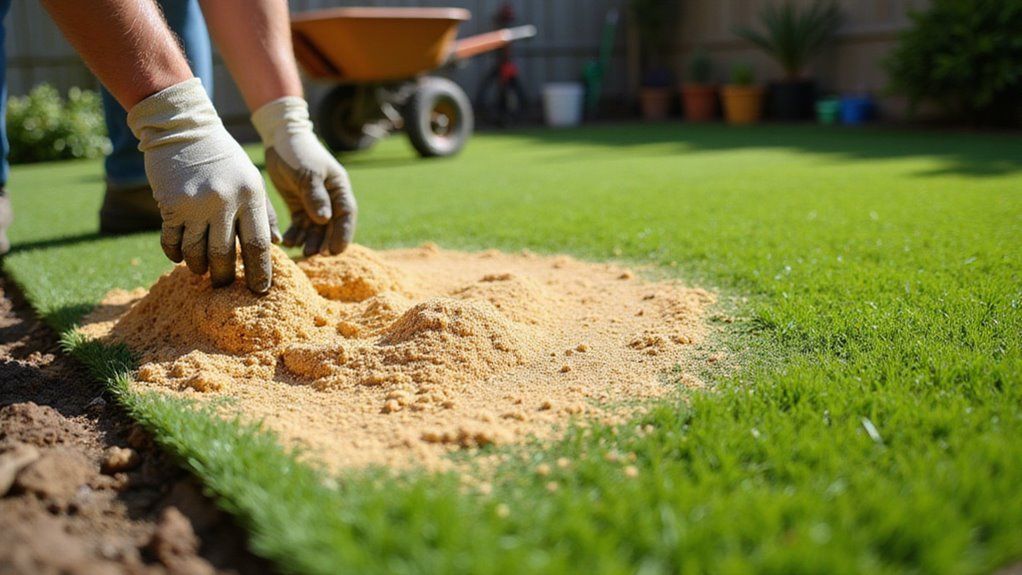
Installing artificial turf seems easy, but many people worry about the right way to begin. One common question is whether sand is needed before laying turf. This small decision can affect your turf’s look and lifespan.
If you skip the sand layer, your turf might not drain well or feel even underfoot. Poor drainage can lead to puddles and bad smells. Uneven ground may also cause the turf to shift or wrinkle over time.
Yes, you should put sand down before laying artificial turf.
Sand creates a stable base and helps with drainage. Using the right sand and applying it correctly boosts your turf’s performance.
This blog will guide you, step by step, to ensure you install your artificial turf the right way.
Key Takeaways
- Yes, a layer of sand is commonly spread and compacted before laying artificial turf to create a stable, level base.
- Sand improves drainage, prevents turf shifting, and helps the artificial grass blades remain upright for a natural look.
- Use sharp sand or properly graded silica sand to ensure optimal stability and water flow.
- The recommended amount is typically 20–25 kg of sand per square meter, spread evenly and compacted thoroughly.
- Proper preparation—including removing debris and leveling the area—is essential before adding sand and installing turf.
Understanding the Role of Sand in Artificial Turf Installation
Sand is important in artificial turf installation because it helps keep the turf stable and level. The sand infill creates a firm base and prevents the turf from shifting. If you use sand, it also helps blades stand upright and look natural.
Sand fills the spaces between grass blades and makes the surface even. It also improves drainage and reduces water pooling. Using sand as an infill is essential for proper drainage, as it encourages water to flow through the turf and prevents soggy spots. Proper sand infill can keep the turf looking good for a long time.
Without enough sand, the turf may become uneven or wear out quickly. If you skip this step, the surface might not absorb shock well. Using the right amount of sand will improve the turf’s durability and comfort. Sand also enhances the durability of artificial turf, ensuring it withstands heavy use and lasts for years.
Types of Sand Commonly Used Under Artificial Turf
Sharp sand and silica sand are the most common choices under artificial turf. Sharp sand has angular grains, which help keep the turf stable. Silica sand has round grains, which improve drainage and stop the surface from getting hard.
If you want the turf to last, choose sand that does not break down easily. Lighter colored sand can keep the turf cooler if heat is a concern. Darker sand may look better with some types of turf. Using clean, properly graded sand can also enhance the turf’s overall durability and long-term appearance.
Always check that the sand is clean and properly graded before using it. If the sand is dirty or mixed with other materials, it can harm the turf. Make sure to pick the right type for your needs. For inspiration on blending natural beauty with functionality, some parks use "lush vegetation and diverse wildlife" as guiding themes in their landscaping choices.
Benefits of Using Sand as a Base Layer
When you use sand as a base layer, you’re optimizing drainage, which helps prevent water pooling on your turf. This material also creates a firm, level foundation that boosts surface stability and minimizes shifting.
Additionally, a compacted sand base acts as a barrier to suppress weed growth beneath your artificial grass. For even greater surface stability, many installation guides recommend combining sand with a gravel layer, which further enhances drainage and long-term turf performance.
Using sand can also contribute to long-term durability, helping your artificial grass last longer with minimal maintenance needs.
Enhanced Drainage Capabilities
Sand allows water to drain quickly through artificial turf. This prevents puddles and flooding on the surface. Good drainage helps keep the turf clean and safe.
The sand base spreads moisture evenly. It also helps stop mold, bacteria, and damage to the turf fibers. Proper drainage can protect the turf’s color and appearance.
If your turf is in a rainy area, a sand base is especially useful. It supports turf durability and keeps it looking good for longer. Sand makes artificial turf more usable after heavy rain or watering.
Improved Turf Stability
A sand base keeps artificial turf stable and level. It stops the surface from shifting or forming bumps over time. If you want long-lasting turf, a sand layer is important.
Sand also helps the turf fibers stand straight. This makes the grass look more natural and neat. The right amount of sand improves the appearance for all turf colors.
If you install turf in high-traffic areas, sand supports the fibers and prevents damage. It also helps turf handle different weather conditions. In summary, a sand base improves both durability and looks.
Weed Growth Prevention
A sand base helps stop weeds from growing under artificial turf. Sand forms a tight layer, blocking sunlight and preventing weed seeds from sprouting. If you use sand correctly, weeds will have a hard time breaking through.
Sand fills empty spaces under the turf. This reduces places where weeds could start to grow. It also helps keep the ground smooth and even.
A sand base can also make it harder for insects and pests to live under the turf. If you want your artificial grass to look neat, sand keeps the surface clean. Proper installation with sand means less maintenance and fewer weeds.
Drainage Considerations for Artificial Turf
Proper drainage keeps artificial turf dry and safe. It helps prevent water from pooling and damaging the turf surface. Good drainage also keeps turf colors bright by avoiding water stains or algae.
When preparing your turf installation, it's important to install a four-inch base of compacted road base rock or similar material beneath the turf to create a solid foundation and help direct water away effectively.
A well-prepared sub-base, like crushed stone, should be used under the turf. The base needs to slope slightly to guide water away. If you skip this step, you may see water collect on top.
Artificial turf with small holes in the backing allows water to pass through. Seams between turf pieces must line up to let water drain evenly. Without these features, the turf can become waterlogged.
Regular inspection of your drainage system is important. Maintenance tools can help you check for clogs or soil compaction. If you notice standing water, you should fix it quickly.
One common way to keep water flowing away from artificial turf is using a graded sub-base under areas like front and back lawns, pool surrounds, or play zones. Good drainage keeps artificial turf looking new and working well.
How Sand Enhances Turf Stability and Longevity
Sand improves turf stability and helps turf last longer. It holds the turf in place and keeps the surface even. If sand is used, the turf is less likely to shift or wrinkle.
Sand also supports the turf fibers so they stand upright. This reduces the chance of erosion or the turf wearing down. If sand is spread evenly, it protects the surface from becoming hard or misshapen. Occasional debris removal is recommended to keep the sand and turf in top condition.
A turf system with sand stays strong even if many people walk on it. Proper sand infill ensures the turf keeps its shape over time. If you want a durable turf, sand is an important part of the installation.
Regular maintenance, such as brushing against the grain, helps the sand stay evenly distributed and keeps the turf looking its best.
The Impact of Sand on Turf Appearance and Feel
Sand improves how artificial turf looks and feels. When added to turf, sand helps the surface look green and natural. It also stops the blades from flattening.
The sand infill holds the synthetic grass upright. If you use sand, the turf will keep its shape and color longer. Sand also helps prevent uneven spots. Another benefit is that sand infill can contribute to the durability and quality of artificial turf over time.
Sand makes the turf feel softer and more stable underfoot. It cushions each step and lessens the impact on your joints. If you want cool turf, sand helps reduce heat on hot days.
Choosing sand is important if you need your turf to look good and feel comfortable. Sand is a key step in getting the best results from artificial grass.
Because Tequesta, Florida is known for its beautiful parks and green spaces, using sand infill can help private lawns match the area's natural look and feel.
Preparing the Ground Before Adding Sand
You need to prepare the ground well before adding sand to artificial turf. Good preparation creates a strong, flat, and well-draining base. If you skip this step, your turf may not last long.
Start by removing all grass, roots, rocks, and debris from the area. Soil must be compacted using a plate compactor to make it stable.
If the ground is too loose, the turf might shift later. Just as preserving natural habitats at places like Hobe Sound Nature Center requires attention to detail, so does preparing the foundation for artificial turf.
Check the soil’s moisture before compacting it. Soil should not be too wet or too dry for best results. Level the ground carefully to avoid bumps or dips.
Always smooth out any uneven spots before adding sand. If you miss any low areas, water can collect there. Proper ground preparation helps your artificial turf look and perform better.
Artificial turf relies on a well-draining base to enhance performance and ensure the field remains usable in different weather conditions.
Step-by-Step Guide to Laying Sand Under Turf
Start by spreading a layer of sharp sand evenly over the prepared ground. Sharp sand with angular grains is best for drainage and stability. Use a wheelbarrow and shovel to move the sand.
A landscaping rake helps make the surface even and smooth. If you want a flat base, use a vibrating plate compactor to press the sand down. This step removes air pockets and firms up the area.
Check the surface level with a straightedge or spirit level. Make small adjustments if you find uneven spots. If your area gets heavy rain or freezing, compact the sand well to help with drainage and settling.
Choosing the right artificial grass is also important at this stage, as different types may require slightly different base preparations. Once the sand is level and firm, you can move on to laying the turf.
How Much Sand Do You Need for Your Project?
To find out how much sand you need, measure your project area in square meters. Each square meter usually needs 20–25 kg of sharp sand. This amount forms a stable base for artificial turf.
If you use too much sand, the surface can become uneven. Too little sand may cause drainage or stability problems. Always check the turf manufacturer’s guide for exact sand requirements.
You should level and compact the sand before laying the turf. Compact sand creates a firm and even surface. Proper preparation makes your turf last longer and easier to maintain.
Alternatives to Sand for Artificial Turf Bases
If you’re considering alternatives to sand for your artificial turf base, you’ve got several effective options. Crushed stone, rubber granules, and recycled aggregate materials each offer unique benefits for drainage, stability, and environmental impact. Let’s compare these base materials so you can select the best fit for your project requirements.
Crushed Stone Base Options
Crushed stone is a strong and reliable base for artificial turf. It provides better drainage, stability, and long-lasting support than sand. If you want to control pests and keep your yard looking neat, consider using crushed stone.
Decomposed granite packs tightly and drains water well. Class II road base is a mix of stone and fines, good for busy areas. Crushed limestone can keep pests away and holds up over time.
Angular gravel interlocks for a firm surface. If you need a flat and steady turf area, proper compaction is important. Each of these options helps prevent weeds and shifting.
Rubber Granule Alternatives
Rubber granules are a good alternative to sand for artificial turf bases. They offer shock absorption and durability for synthetic grass. Many people use them for sports fields and playgrounds.
Installers spread rubber granules evenly over the turf. This helps the turf stay soft and reduces compaction. Rubber granules also improve drainage and keep the turf cooler.
If you choose rubber granules, make sure they are high-quality and non-toxic. Cheap materials can cause odor or break down quickly. Although rubber granules cost more than sand, they last longer and provide better safety.
Recycled Aggregate Materials
Recycled aggregate materials are a good choice for the base of artificial turf. These materials include crushed concrete, brick, or asphalt. Using them is both sustainable and affordable.
Recycled aggregates help water drain quickly and keep the turf surface stable. They prevent the soil underneath from becoming compacted. This makes the turf last longer and look better.
If you use recycled materials, you help the environment by reusing waste. These aggregates also cost less than new stone or sand. They can handle heavy loads without settling or shifting.
Choose materials with the right size and density for best results. Proper selection and packing improve drainage and turf life. Always check your local rules before using recycled aggregates.
Common Mistakes When Using Sand Under Turf
Using the wrong sand under artificial turf can cause problems with stability, drainage, and appearance. Choosing the incorrect sand type or grain size can prevent water from draining and make the surface uneven. If you do not compact the sand properly, the turf may move or feel unstable.
Using too much sand can create a hard surface and ruin the look of the turf. If you use too little sand, the turf fibers may collapse and look unnatural. Sand that does not match in color can make seams and infill stand out.
If you want your turf to last and look good, use the right sand and follow installation steps. Always check the sand type, grain size, and color before starting. Proper compaction and the right amount of sand are important for a stable and attractive surface.
Maintenance Tips for Sand-Based Artificial Turf Installations
Sand-based artificial turf needs regular care to stay in good condition. Simple maintenance helps your turf last longer and look better. If you ignore upkeep, repair costs will quickly add up.
Regular care keeps sand-based artificial turf looking great and lasting longer—neglect leads to expensive repairs.
You should brush the turf often to keep the sand even and the fibers standing up. Regular brushing prevents the surface from getting flat or worn out. Proper brushing also helps the turf look neat.
Check the sand infill levels from time to time. If the sand is low, add more to keep the surface soft and well-drained. A well-maintained infill protects the turf and supports drainage.
Remove leaves and other debris quickly to stop the sand from getting packed down. If debris stays too long, it can lead to mold or bad smells. Clean turf is safer and lasts longer.
Inspect the seams and edges for any gaps or lifting. Fix any problems early to avoid bigger issues later. Early repairs reduce the need for costly fixes.
Comparing Sand Infill vs. Sub-Base Sand
You’ll need to distinguish between sub-base sand, which stabilizes the foundation and ensures proper drainage, and sand infill, which supports turf fibers and boosts surface performance.
Each material serves a unique role in the installation process. Understanding these differences helps you select the right products for structural integrity and playability.
Purpose of Sub-Base Sand
Sub-base sand acts as the main support layer under artificial turf. It is different from sand infill, which is spread on top of the turf. Sub-base sand is used to make the ground stable and level before installing artificial grass.
This sand helps compact the soil, making the base strong for long-term use. It controls moisture, so water does not collect under the turf. If you do not use a proper sub-base, the turf may shift or sink over time.
The sand’s texture allows it to be pressed tightly, creating a smooth and even surface. It also reduces the chance of bumps or dips appearing later. A good sub-base helps your artificial turf last longer and stay even.
Benefits of Sand Infill
Sand infill is important for artificial turf because it helps the turf stay stable and look natural. It holds the turf fibers upright and makes the surface more durable. If you use sand infill, the grass will not shift or flatten easily.
Sand infill also improves the appearance of the turf by supporting even fiber positioning. It keeps the turf looking lush and helps the color stay bright. If you want to avoid fading or matting, choose a quality sand infill.
The sand infill helps with safety and comfort by reducing surface friction and heat. It can make the turf feel cooler on sunny days. Always use silica sand designed for artificial grass for best results.
Environmental Considerations When Using Sand With Artificial Turf
Using sand with artificial turf can affect the environment in several ways. Sand may wash away, pollute water, or harm nearby soil if not managed well. Careful planning can lower these risks.
High-quality, clean sand should be chosen to avoid adding pollutants. Perimeter edging can help keep sand in place and prevent runoff. Good drainage systems help avoid waterlogging and stop sand from spreading.
Local rules should be checked before installing or replacing turf. Sand and turf must be disposed of properly to protect the environment. Following these steps can help reduce harm to nature.
Conclusion
If you want long-lasting artificial turf, you should always lay sand before installation. The sand helps create a stable and even base. Without it, your turf might develop bumps or poor drainage over time.
If you use clean, compacted sand, your turf will look smooth and last longer. Proper preparation also prevents issues like shifting or uneven wear. Good drainage from a sand base protects your investment.
If you want a flawless result, trust the experts at Synthetic Turf Treasure Coast. Contact us today to install your artificial grass the right way. Enjoy a beautiful, durable lawn for years to come.
About the author
Kathy Leavell
Kathy Leavell is the founder and owner of Synthetic Turf Treasure Coast, a leading provider of synthetic grass solutions for residential and commercial properties in Florida. With over a decade of experience in the industry, Kathy has become a recognized expert in synthetic turf installation, maintenance, and repair. Under her leadership, Synthetic Turf Treasure Coast has earned a reputation for exceptional customer service and high-quality workmanship.
Prior to starting her own business, Kathy worked in sales and marketing roles at several major synthetic turf manufacturers.

